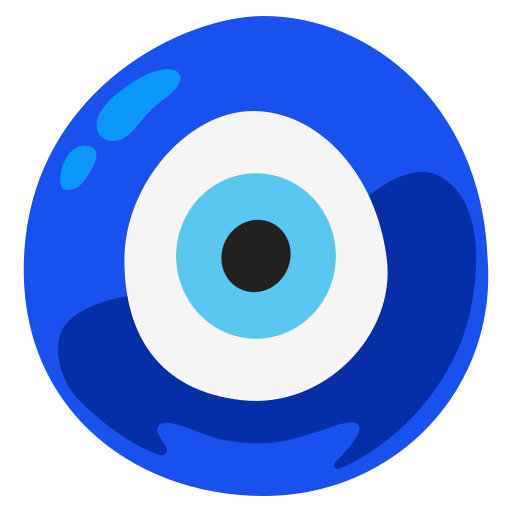The evil eye symbol has been around for centuries and it is still heavily used in many cultures and religions today. It is often seen as a talisman or amulet that can protect people from negative energies or harm. In recent years, the evil eye symbol has also become popular as an emoji, known as the 🧿 emoji. In this article with Impeccable Nest, we will explore the 🧿 meaning and its significance in various contexts.

What is the 🧿 meaning?
The 🧿 emoji is a popular symbol that has been used for centuries in various cultures around the world as a means of protection against evil or harm. The symbol itself represents an eye that is believed to have mystical powers and is said to be able to ward off evil spirits and negative energy.
The evil eye symbol has its roots in ancient Middle Eastern and Mediterranean cultures, where it was considered a powerful talisman to protect against the evil gaze of others. It was believed that when someone looked at another person with envy or jealousy, they could inadvertently bring harm to them. This belief was taken so seriously that people would wear amulets or charms with the evil eye symbol to protect themselves from harm.
Over time, the evil eye symbol has become a universal symbol of protection across many cultures and religions. In some cultures, the symbol is still used as a talisman to ward off evil spirits and negative energy. In other cultures, the symbol has become more of a decorative element, used in fashion and home decor.
The 🧿 emoji is an extension of this tradition and is often used on social media and messaging platforms to convey a sense of protection or good luck. It can be used as a way to show support or encouragement to someone who may be going through a difficult time. It can also be used as a way to express gratitude or appreciation for something positive that has happened.
In some contexts, the 🧿 emoji may be seen as a sign of superstition or belief in the supernatural. However, for many people, it is simply a way to connect with their cultural heritage or to express their personal beliefs about the power of symbols and imagery.
In conclusion, the 🧿 emoji represents the traditional evil eye symbol, which is believed to have protective powers against evil and negative energy. Its meaning may vary depending on the culture or context, but it is generally seen as a symbol of good luck and protection. Whether used for its mystical powers or as a decorative element, the 🧿 emoji continues to be a popular symbol that is recognized and appreciated by people around the world.
Origins and History of the Evil Eye
Belief in the evil eye dates back to ancient Greece and Rome. It was also prevalent in the Middle East, Africa, and Europe. The evil eye was thought to cause disease, drought, and disaster. People used amulets and rituals to defend themselves against it.
One of the earliest artistic depictions appears in ancient Egypt. The Eye of Horus, which represents protection, power and good health, looks very similar to the modern evil eye emoji.
In the Mediterranean, people used blue orbs to symbolize the evil eye and defend against its power. The most common method was utilizing blue glass, pottery, jewelry, and beads in the shapes of eyes. The blue color was thought to symbolize heaven or godliness, which provided safety from the curse. This is why the modern evil eye emoji features a blue eye.
Spread Through Religion and Folklore
As major religions like Islam, Judaism and Christianity grew, belief in the destructive power of the evil eye also spread. It is referenced in religious texts like the Quran and Bible. Jewish tradition utilizes the Hamsa hand with an eye to fight the effects of the evil eye.
The evil eye grew prominently in Greek culture. Greeks painted evil eye symbols on their boats, doors, and other structures for protection. Belief in the curse persisted through the Middle Ages and into modern times across the Mediterranean region.
Folklore and mythology helped ingrain the evil eye in many cultures. Stories featured villains who could cast harmful spells on victims with just a glance. Babies and pregnant women were considered the most vulnerable.
Persisting in the Present Day
While belief in mystical curses has declined in modern times, the idea of the evil eye persists. In the Middle East, Africa, and parts of Europe, using blue beads, amulets, charms, and other representations of eyes remains popular for warding off bad luck.
The evil eye emoji has renewed interest and belief in the curse. People use the icon in text messages and social media posts to suggest someone has malicious intent behind their admiring or envious glances. While the supernatural elements may have faded, the emoji keeps the symbolic meaning alive.
Using the Evil Eye Emoji
The evil eye emoji has a few key uses in modern digital communication:
- Suggesting someone is envious of you
- Accusing someone of giving you the “evil eye”
- Wishing bad luck on someone
- Wishing to protect yourself from ill will
- Reacting to a situation caused by envy or negativity
For example:
- “I got the promotion Amy always wanted. I bet she’s giving me the evil eye emoji right now.”
- “Good luck on your test tomorrow! Here’s a protective evil eye emoji to keep the haters away 🧿”
- “I can’t believe you stole my idea and presented it as your own. Take this evil eye emoji as payback 🧿”
The evil eye emoji works particularly well for exaggerated, humorous, or sarcastic statements. It adds a mystical edge to any accusation of envy or malice. Some also just find the icon’s mystical look visually appealing for accentuating text messages.
The Evil Eye Emoji in Design and Marketing
Beyond digital communication, the evil eye emoji influences visual culture. It appears in designs for clothing, jewelry, tattoos, home decor, and more. Some examples include:
- T-shirts and hats featuring the emoji
- Blue evil eye necklaces and bracelets
- Evil eye motifs on handbags and keychains
- Tattoos incorporating the emoji, often on hands and arms
- Posters and wall hangings with the emoji as decoration
This usage relates back to the protective properties of the symbol and its history in amulets and ornaments. The evil eye’s distinctive look makes it aesthetically pleasing for decorative purposes.
Some companies leverage the emoji in marketing and branding. Using the evil eye emoji suggests their product will protect against envy and ill will. It connects their brand to the mystical idea of deflecting negativity.
Overall, the evil eye emoji endures because of its striking appearance and connection to an ancient superstition that still lingers today. It adds an air of mystery and intrigue to digital communication and visual culture.
Examples of the 🧿 symbol in different cultures
The 🧿 symbol has been used for centuries across many cultures and religions. Here are some examples:
- In Middle Eastern cultures: The evil eye symbol is known as “nazar” and it is believed to protect against the evil eye curse. It is commonly used in jewelry, home decor, or textiles.
- In Mediterranean cultures: The symbol is called “malocchio” and it is believed to have the power to harm others with just a glance. Therefore, people wear or display the symbol as a protective measure.
- In Hinduism: The symbol is known as “drishti” and it is used to ward off negative energy or the evil eye curse. It can be found in home decor items, such as wall hangings or idols.
- In Judaism: The symbol is called “ayin hara” and it refers to the evil eye curse. It is believed that the curse can be avoided by wearing or displaying the symbol.
Conclusion
The 🧿 symbol, whether in its traditional form or as an emoji, has a long and rich history in many cultures and religions. Its meaning is often associated with protection, good luck, and warding off negative energies or harm. While its use may vary across contexts and cultures, it is important to approach it with respect and intention.In conclusion, the 🧿 meaning and its significance are deeply rooted in many cultures and religions across the globe. Whether you use the traditional evil eye symbol or the emoji version, it can serve as a powerful talisman or decorative item that is believed to offer protection and good luck. It is important to approach the symbol with respect and intention, understanding its cultural context and significance. With this knowledge, you can incorporate the 🧿 symbol into your life in a way that feels authentic and meaningful to you.

I am Lois Mullins, an enthusiast in emoji deciphering. Over the recent years, I have continuously updated and delved deep into the knowledge of emoji decryption.
I take pride in my extensive knowledge of decoding emojis, particularly in the Emoji Meanings of Impeccable Nest . I believe that a profound understanding of decoding these symbols can be beneficial for individuals in comprehending the nuances of language when someone sends them an emoji.
By grasping the nuances and potential misinterpretations of these emotional symbols, I am confident that people can use them more effectively to express their emotions and build stronger connections with others. I am committed to sharing my knowledge with the community so that everyone can harness the power of emojis in their everyday communication.
If you are seeking an experienced individual ready to share their passion for emoji deciphering, I hope for the opportunity to collaborate and learn from others. Together, we can create innovative and unique communication experiences!
